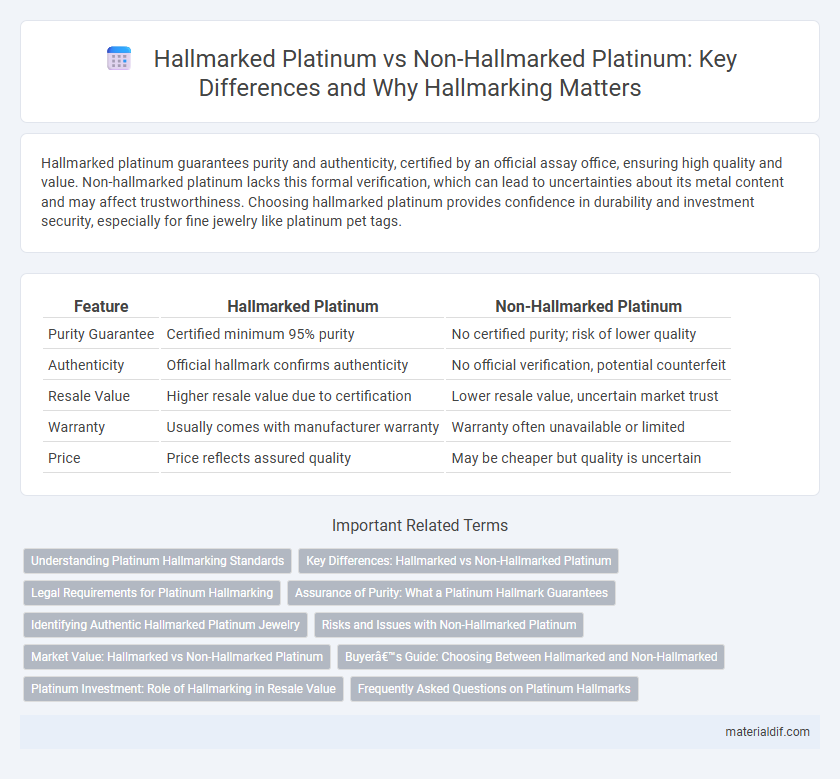Hallmarked platinum guarantees purity and authenticity, certified by an official assay office, ensuring high quality and value. Non-hallmarked platinum lacks this formal verification, which can lead to uncertainties about its metal content and may affect trustworthiness. Choosing hallmarked platinum provides confidence in durability and investment security, especially for fine jewelry like platinum pet tags.
Table of Comparison
| Feature | Hallmarked Platinum | Non-Hallmarked Platinum |
|---|---|---|
| Purity Guarantee | Certified minimum 95% purity | No certified purity; risk of lower quality |
| Authenticity | Official hallmark confirms authenticity | No official verification, potential counterfeit |
| Resale Value | Higher resale value due to certification | Lower resale value, uncertain market trust |
| Warranty | Usually comes with manufacturer warranty | Warranty often unavailable or limited |
| Price | Price reflects assured quality | May be cheaper but quality is uncertain |
Understanding Platinum Hallmarking Standards
Hallmarked platinum guarantees authenticity and purity by meeting strict hallmarking standards set by regulatory authorities, typically indicating a minimum purity of 95% platinum (Pt 950) verified through standardized assays. Non-hallmarked platinum lacks this certification, posing risks of lower purity and potential misrepresentation, which can affect its value and durability. Understanding hallmarking standards ensures informed purchasing decisions, confirming the metal's quality, origin, and compliance with industry regulations.
Key Differences: Hallmarked vs Non-Hallmarked Platinum
Hallmarked platinum undergoes official testing to verify purity, ensuring it meets established standards such as 950 parts per thousand or higher, which guarantees authenticity and quality. Non-hallmarked platinum lacks this certification, posing risks of alloying with inferior metals or misleading purity claims. The hallmark serves as a trusted indicator for buyers and sellers, providing legal protection and enhancing market value compared to uncertified platinum.
Legal Requirements for Platinum Hallmarking
Hallmarked platinum must comply with strict legal requirements that guarantee its purity and authenticity, typically set by governmental assay offices such as the Bureau of Indian Standards or the Assay Office in the UK. These regulations mandate precise testing procedures to ensure the metal meets the minimum platinum content, often 95% or higher, and require official stamping with identifiable marks including the purity grade, assay office symbol, and jeweler's trademark. Non-hallmarked platinum does not undergo this standardized certification process, increasing risks of lower purity levels and potential legal complications in trade and resale.
Assurance of Purity: What a Platinum Hallmark Guarantees
A platinum hallmark guarantees the metal's purity by certifying it meets strict industry standards, typically indicating a minimum of 95% platinum content. This official stamp ensures buyers receive authentic, high-quality platinum, providing confidence in its durability and value. Non-hallmarked platinum lacks this certification, increasing the risk of acquiring alloyed or lower-purity metal without reliable verification.
Identifying Authentic Hallmarked Platinum Jewelry
Hallmarked platinum jewelry carries official marks from authorized assay offices certifying its purity, typically indicating 950 parts per thousand of platinum content, ensuring authenticity and quality. Non-hallmarked platinum lacks these verified stamps, making it difficult to guarantee genuine platinum content or metal quality. Identifying authentic hallmarked platinum jewelry involves checking for clear assay marks such as "Pt950" or "950 Plat" along with a reputable jeweler's signature and certification documents.
Risks and Issues with Non-Hallmarked Platinum
Non-hallmarked platinum carries significant risks including uncertain purity, potential counterfeit status, and compromised durability due to unknown alloy composition. Consumers face financial losses and legal issues when purchasing non-certified platinum, as authenticity cannot be verified through standard assays. Hallmarking ensures genuine platinum content, providing confidence in quality, value retention, and compliance with international trade regulations.
Market Value: Hallmarked vs Non-Hallmarked Platinum
Hallmarked platinum carries a certified purity mark confirming its authenticity and quality, significantly enhancing its market value compared to non-hallmarked platinum, which lacks official verification and carries a higher risk of lower purity or adulteration. Buyers and investors prefer hallmarked platinum due to its guaranteed standard, leading to better pricing and easier resale in the global market. Non-hallmarked platinum often trades at a discount, reflecting uncertainty about its composition and potential legal or financial complications.
Buyer’s Guide: Choosing Between Hallmarked and Non-Hallmarked
Hallmarked platinum guarantees authenticity, purity, and quality verified by authorized assay offices, providing buyers with legal protection and peace of mind. Non-hallmarked platinum lacks official certification, increasing the risk of purchasing substandard or counterfeit metal, which can affect durability and resale value. When choosing between hallmarked and non-hallmarked platinum, prioritize hallmarked options for verified trustworthiness, while non-hallmarked pieces may require expert appraisal to ensure value and authenticity.
Platinum Investment: Role of Hallmarking in Resale Value
Hallmarked platinum certifies authenticity and purity, significantly enhancing confidence for investors and buyers in the resale market. Non-hallmarked platinum lacks standardized verification, often leading to lower resale value due to potential doubts about its genuine content. The hallmark acts as a trusted assurance in platinum investment, directly influencing liquidity and market acceptance.
Frequently Asked Questions on Platinum Hallmarks
Hallmarked platinum guarantees purity and authenticity verified by official assay offices, ensuring the metal meets standardized quality criteria essential for investment and fine jewelry. Non-hallmarked platinum lacks this certification, which can raise concerns about the metal's quality, weight, and genuine platinum content, making it less reliable for resale or warranty claims. Consumers frequently ask about hallmark symbols, the minimum platinum purity required (usually 95% or higher), and how to verify a hallmark's legitimacy through accredited assay offices or trusted jewelers.
Hallmarked Platinum vs Non-Hallmarked Platinum Infographic

 materialdif.com
materialdif.com